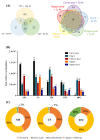Food Service Kitchen Scraps as a Source of Bioactive Phytochemicals: Disposal Survey, Optimized Extraction, Metabolomic Screening and Chemometric Evaluation
- PMID: 36984826
- PMCID: PMC10057048
- DOI: 10.3390/metabo13030386
Food Service Kitchen Scraps as a Source of Bioactive Phytochemicals: Disposal Survey, Optimized Extraction, Metabolomic Screening and Chemometric Evaluation
Abstract
Untargeted metabolomics is a powerful tool with high resolution and the capability to characterize a wide range of bioactive natural products from fruit and vegetable by-products (FVB). Thus, this approach was applied in the study to evaluate the phenolic compounds (PC) by metabolomic screening in five FVB after optimizing their extraction. The total phenolic content and antioxidant activity analyses were able to select the best extractor (SM) and ultrasonication time (US) for each FVB; methanol was used as a control. Although ultrasonication yielded a lower number of PC identifications (84 PC), the US extract was the most efficient in total ionic abundance (+21% and +29% compared to the total PC and SM extracts, respectively). Ultrasonication also increased the phenolic acid (+38%) and flavonoid classes (+19%) extracted compared to SM, while the multivariate analyses showed the control as the most dissimilar sample. FVB extracted from the same parts of the vegetable/fruit showed similarities and papaya seed presented the most atypical profile. The application of the metabolomics approach increased the knowledge of the bioactive potential of the evaluated residues and possibilities of exploring and valorizing the generated extracts.
Keywords: bioactive compounds; fruit and vegetable non-edible parts; health-promoting foods; metabolomics; waste.
Conflict of interest statement
The authors declare no conflict of interest.
Figures





References
-
- WHO . Fruit and Vegetables for Health. Report of the Joint FAO/WHO Workshop on Fruit and Vegetables for Health. World Health Organization; Geneva, Switzerland: 2005.
-
- FAO . The International Year of Fruits and Vegetables. FAO; Rome, Italy: 2020. Fruit and vegetables—your dietary essentials. - DOI
-
- Alsayed H., Ahmed A.R., Al-Sayed H.M.A. Utilization of watermelon rinds and sharlyn melon peels as a natural source of dietary fiber and antioxidants in cake. Ann. Agric. Sci. 2013;6:11–18. doi: 10.1016/j.aoas.2013.01.012. - DOI
-
- Kühn S., Wollseifen H., Galensa R., Schulze-Kaysers N., Kunz B. Adsorption of flavonols from onion (Allium cepa L.) processing residues on a macroporous acrylic resin. Food Res. Int. 2014;65:103–108. doi: 10.1016/j.foodres.2014.03.014. - DOI
Grants and funding
- 427116/2018-0/National Council for Scientific and Technological Development
- 310343/2019-4/National Council for Scientific and Technological Development
- 26/010.000171/206/Fundação Carlos Chagas Filho de Amparo à Pesquisa do Estado do Rio de Janeiro
- 26/010.100988/2018/Fundação Carlos Chagas Filho de Amparo à Pesquisa do Estado do Rio de Janeiro
- 26/202/709-2018/Fundação Carlos Chagas Filho de Amparo à Pesquisa do Estado do Rio de Janeiro
LinkOut - more resources
Full Text Sources

